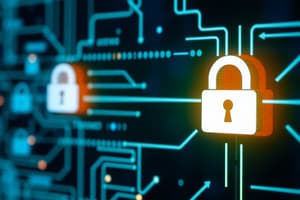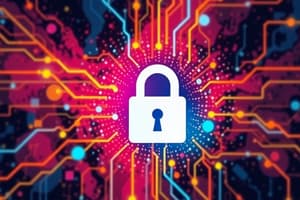Podcast
Questions and Answers
An organization discovers an employee is consistently accessing sensitive data outside of their role requirements. This scenario is MOST indicative of what type of threat?
An organization discovers an employee is consistently accessing sensitive data outside of their role requirements. This scenario is MOST indicative of what type of threat?
- An insider threat. (correct)
- An Advanced Persistent Threat (APT).
- A Distributed Denial-of-Service (DDoS) attack.
- A vulnerability scan revealing outdated software.
Which cybersecurity measure focuses on converting data into an unreadable format to protect its confidentiality?
Which cybersecurity measure focuses on converting data into an unreadable format to protect its confidentiality?
- Multi-Factor Authentication (MFA)
- Intrusion Detection Systems (IDSs)
- Encryption (correct)
- Firewalls
A cybersecurity team is planning to proactively identify weaknesses in their systems. Which of the following methods would BEST simulate real-world attack scenarios?
A cybersecurity team is planning to proactively identify weaknesses in their systems. Which of the following methods would BEST simulate real-world attack scenarios?
- Performing penetration testing. (correct)
- Implementing multi-factor authentication.
- Reviewing and updating security policies.
- Conducting vulnerability scanning.
An organization wants to enhance its authentication process. Which of the following options provides the MOST secure approach?
An organization wants to enhance its authentication process. Which of the following options provides the MOST secure approach?
Which of the following is NOT a typical application of AI and Machine Learning (ML) in cybersecurity?
Which of the following is NOT a typical application of AI and Machine Learning (ML) in cybersecurity?
Which of the following scenarios best illustrates a violation of the principle of 'Integrity' in cybersecurity?
Which of the following scenarios best illustrates a violation of the principle of 'Integrity' in cybersecurity?
In the context of cybersecurity, why is an interdisciplinary approach considered important?
In the context of cybersecurity, why is an interdisciplinary approach considered important?
A software development company is creating a new application. Which of the following practices would MOST directly address cybersecurity concerns during the software engineering process?
A software development company is creating a new application. Which of the following practices would MOST directly address cybersecurity concerns during the software engineering process?
A company suspects it has been the victim of a Man-in-the-Middle (MitM) attack. Which of the following observations would provide the STRONGEST evidence supporting this suspicion?
A company suspects it has been the victim of a Man-in-the-Middle (MitM) attack. Which of the following observations would provide the STRONGEST evidence supporting this suspicion?
A cybersecurity analyst is investigating a breach and needs to gather evidence from compromised systems. Which specialization is MOST relevant to this task?
A cybersecurity analyst is investigating a breach and needs to gather evidence from compromised systems. Which specialization is MOST relevant to this task?
Which of the following security measures primarily addresses the cybersecurity principle of 'Authentication'?
Which of the following security measures primarily addresses the cybersecurity principle of 'Authentication'?
An organization is developing its incident response plan. Which of the following steps is MOST critical in ensuring an effective response?
An organization is developing its incident response plan. Which of the following steps is MOST critical in ensuring an effective response?
An organization wants to improve its resilience against ransomware attacks. Which of the following strategies would be MOST effective in achieving this goal?
An organization wants to improve its resilience against ransomware attacks. Which of the following strategies would be MOST effective in achieving this goal?
Which emerging trend aims to secure data and applications hosted on platforms like AWS, Azure, and Google Cloud?
Which emerging trend aims to secure data and applications hosted on platforms like AWS, Azure, and Google Cloud?
In the context of cybersecurity, what is the PRIMARY purpose of 'Non-Repudiation'?
In the context of cybersecurity, what is the PRIMARY purpose of 'Non-Repudiation'?
As quantum computing becomes more prevalent, which area of cybersecurity requires the MOST urgent attention and research?
As quantum computing becomes more prevalent, which area of cybersecurity requires the MOST urgent attention and research?
Which of the following attack types relies HEAVILY on psychological manipulation to trick individuals into divulging sensitive information?
Which of the following attack types relies HEAVILY on psychological manipulation to trick individuals into divulging sensitive information?
Which of the following is the BEST example of applying the principle of 'Least Privilege' in a corporate network environment?
Which of the following is the BEST example of applying the principle of 'Least Privilege' in a corporate network environment?
Flashcards
Computer Science
Computer Science
The study of computation and information, including the theory, design, development, and application of computer systems.
Cybersecurity
Cybersecurity
Protecting computer systems and networks from digital attacks, theft, damage, or unauthorized access.
Algorithms & Data Structures
Algorithms & Data Structures
Fundamental methods for efficiently solving problems and organizing data in computer programs.
Programming Languages
Programming Languages
Signup and view all the flashcards
Confidentiality
Confidentiality
Signup and view all the flashcards
Integrity
Integrity
Signup and view all the flashcards
Malware
Malware
Signup and view all the flashcards
Phishing
Phishing
Signup and view all the flashcards
Insider Threats
Insider Threats
Signup and view all the flashcards
Advanced Persistent Threats (APTs)
Advanced Persistent Threats (APTs)
Signup and view all the flashcards
Firewalls
Firewalls
Signup and view all the flashcards
Intrusion Detection Systems (IDSs)
Intrusion Detection Systems (IDSs)
Signup and view all the flashcards
Intrusion Prevention Systems (IPSs)
Intrusion Prevention Systems (IPSs)
Signup and view all the flashcards
Encryption
Encryption
Signup and view all the flashcards
Multi-Factor Authentication (MFA)
Multi-Factor Authentication (MFA)
Signup and view all the flashcards
Vulnerability Scanning
Vulnerability Scanning
Signup and view all the flashcards
Penetration Testing
Penetration Testing
Signup and view all the flashcards
Security Awareness Training
Security Awareness Training
Signup and view all the flashcards
Study Notes
- Computer science encompasses the study of computation and information.
- It deals with the theory, design, development, and application of computer systems.
- Cybersecurity involves protecting computer systems and networks from information disclosure, theft of, or damage to their hardware, software, or electronic data, as well as from disruption or misdirection of the services they provide.
Core Areas of Computer Science
- Algorithms and Data Structures: Fundamental techniques for efficient problem-solving and data organization.
- Programming Languages: Principles and paradigms for designing and implementing programming languages.
- Computer Architecture: Design and organization of computer hardware components.
- Operating Systems: Management of computer resources and provision of system services.
- Databases: Principles and systems for storing, retrieving, and managing data.
- Artificial Intelligence: Development of intelligent agents that can reason, learn, and act autonomously.
- Computer Networks: Principles and protocols for communication between computers.
- Software Engineering: Methodologies and tools for developing high-quality software systems.
- Theory of Computation: Abstract models of computation and their limitations.
Key Cybersecurity Concepts
- Confidentiality: Ensuring that information is accessible only to authorized individuals.
- Integrity: Maintaining the accuracy and completeness of information.
- Availability: Ensuring that authorized users have reliable access to information and resources.
- Authentication: Verifying the identity of users, devices, or systems.
- Authorization: Granting permissions to access specific resources or perform specific actions.
- Non-Repudiation: Preventing individuals from denying that they took a certain action.
Cybersecurity Threats
- Malware: Malicious software, such as viruses, worms, and Trojans, designed to harm computer systems.
- Phishing: Deceptive attempts to obtain sensitive information, such as usernames, passwords, and credit card details, by disguising oneself as a trustworthy entity.
- Ransomware: A type of malware that encrypts a victim's files and demands a ransom payment to restore access.
- Denial-of-Service (DoS) Attacks: Overwhelming a target system with traffic, making it unavailable to legitimate users.
- Man-in-the-Middle (MitM) Attacks: Intercepting communication between two parties without their knowledge.
- Social Engineering: Manipulating individuals into divulging confidential information or performing actions that compromise security.
- Insider Threats: Security risks originating from individuals within an organization.
- Advanced Persistent Threats (APTs): Sophisticated, long-term attacks carried out by highly skilled adversaries.
Cybersecurity Measures
- Firewalls: Network security systems that control incoming and outgoing network traffic based on predetermined security rules.
- Intrusion Detection Systems (IDSs): Systems that monitor network traffic for suspicious activity and alert administrators.
- Intrusion Prevention Systems (IPSs): Systems that detect and prevent malicious network activity.
- Antivirus Software: Software that detects, prevents, and removes malware.
- Encryption: Converting data into an unreadable format to protect its confidentiality.
- Multi-Factor Authentication (MFA): Requiring users to provide multiple forms of identification before granting access.
- Security Audits and Assessments: Regular reviews of security policies, procedures, and controls.
- Vulnerability Scanning: Identifying security weaknesses in systems and applications.
- Penetration Testing: Simulating real-world attacks to assess the effectiveness of security measures.
- Security Awareness Training: Educating users about cybersecurity threats and best practices.
- Incident Response Planning: Developing procedures for responding to security incidents.
Overlap between Computer Science and Cybersecurity
- Cryptography: A field that applies mathematical principles to secure communication and data storage, involving algorithm design and analysis (Computer Science) for encryption, digital signatures, and secure protocols (Cybersecurity).
- Network Security: Computer science principles of networking are essential to understanding network vulnerabilities and developing security measures.
- Secure Software Development: Computer science practices in software engineering must incorporate security considerations to minimize vulnerabilities in software applications.
- Malware Analysis: Understanding the structure and behavior of malware requires computer science skills in reverse engineering, programming, and operating systems.
- Intrusion Detection and Prevention Systems (IDS/IPS): The development and operation of these systems rely on computer science principles in network analysis, pattern recognition, and machine learning.
- Forensics: Digital forensics involves using computer science tools and techniques to investigate security incidents and gather evidence.
- Risk Management: Cybersecurity risk management involves assessing and mitigating potential threats, often using computer science models and simulations.
- Artificial Intelligence (AI) and Machine Learning (ML) in Cybersecurity: AI and ML are increasingly used in cybersecurity for tasks such as threat detection, anomaly detection, and automated incident response.
Specializations in Computer Science Relevant to Cybersecurity
- Computer Networks: Crucial for understanding network protocols, architectures, and security vulnerabilities.
- Operating Systems: Understanding OS internals is critical for identifying and mitigating security flaws.
- Databases: Expertise in database security is essential for protecting sensitive data.
- Artificial Intelligence: AI techniques are used for threat detection, malware analysis, and security automation.
- Software Engineering: Secure coding practices are essential for building robust and secure software applications.
Specializations in Cybersecurity
- Security Architecture: Designing and implementing secure systems and networks.
- Penetration Testing: Assessing the security of systems by simulating real-world attacks.
- Incident Response: Responding to and recovering from security incidents.
- Digital Forensics: Investigating security incidents and gathering evidence.
- Cryptography: Designing and implementing cryptographic algorithms and protocols.
- Security Auditing: Evaluating the effectiveness of security controls.
- Compliance: Ensuring that organizations comply with relevant security regulations and standards.
- Threat Intelligence: Gathering and analyzing information about potential threats.
Importance of Interdisciplinary Approach
- Cybersecurity problems often require a combination of technical skills (from computer science) and domain-specific knowledge (e.g., legal, regulatory, business).
- Effective cybersecurity solutions require collaboration between experts from different fields.
Emerging Trends
- Cloud Security: Securing data and applications in cloud environments.
- Internet of Things (IoT) Security: Protecting the growing number of IoT devices from cyberattacks.
- Artificial Intelligence (AI) and Machine Learning (ML) for Cybersecurity: Using AI and ML to automate threat detection and incident response.
- Blockchain Security: Addressing security challenges in blockchain-based systems.
- Quantum Computing and Cryptography: Developing cryptographic algorithms that are resistant to attacks from quantum computers.
Studying That Suits You
Use AI to generate personalized quizzes and flashcards to suit your learning preferences.




